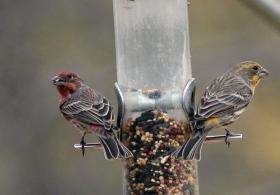Researchers investigate bird's 'carotenoid circle of life'

(ĖĮÐÄĘÓÆĩOrg.com) -- âWhat you see is what you getâ often is the mantra in the highly competitive life of birds, as they use brilliant displays of color to woo females for mating. Now researchers are finding that carotenoids - the compounds responsible for amping up red, orange and yellow colors of birds - also may play a role in color perception and in a birdâs ability to reproduce, making it a cornerstone in birdsâ vitality.
These are among the findings presented by Kevin McGraw, an Arizona State University assistant professor in the School of Life Sciences, at the American Association for the Advancement of Science annual meeting in Chicago. McGraw presented his findings Feb. 13 during a special session on evolutionary biology, called âBeyond the beagle: evolutionary approaches to the study of social behavior.â
âCarotenoids play fascinating and multifaceted roles in the lives of animals,â McGraw said. âFor years, we have known that, as antioxidants, they boost human health and, as colorants, make birds colorful and sexually attractive. Now, we are blending as well as expanding these paradigms and studying how consumption of carotenoids can improve or âtuneâ their color vision, promote the health of offspring as they develop in the egg, and possibly improve male sperm quality.â
McGraw presented his findings in the paper, âCarotenoids as narcissistic agents of color evolution: A birdâs eye view.â McGraw, a biochemical ecologist and evolutionary biologist who has studied diet, coloration and physiology in birds, led the work that included post-doctoral researcher Melissah Rowe and Ph.D. student, Matthew Toomey.
Researchers have long thought that carotenoids - responsible for the orange color of carrots and the red of lobster - play an important role in the evolutionary lives of birds by providing them with health benefits and vibrant colors. Because these pigments are limited in the diet and for physiological purposes, their use in coloration provides âhonest, accurate informationâ about the birdâs overall quality as a mate. McGrawâs new work expands the scope of research on carotenoids to include many other behavioral and physiological benefits they may provide, including superior color perception and gamete formation.
âLike in humans, carotenoids are also deposited in the retina, where they may protect the eye from photodamage by the Sun. There also is evidence that they can shape how well colors can be discriminated visually,â McGraw explained. âUltimately, we envision a model where the more carotenoids you eat, the better you can see color, the better mates you choose, and the redder the foods you choose, thus giving you even more carotenoids for health, attractiveness and vision. In a sense it is a carotenoid circle of life.â
McGraw and colleagues are studying a native Arizona desert songbird species (the house finch) as well as two widespread ducks (mallard and northern pintail) to better understand how carotenoids are allocated and prioritized among all of these diverse fitness (survival and reproduction) functions.
âFor decades, poultry scientists and human egg-consumers have been interested in the carotenoids that chicken hens put into their yellow egg yolks. We now know that these nutrients aid in the health, growth, and perhaps eventual coloration and mate quality of their offspring,â McGraw said. Carotenoids may also affect the male gametes, sperm.
âTestes and seminal fluid can be enriched with carotenoids, preventing sperm cells from oxidative damage and resulting in greater fertilization ability of males,â McGraw explained. âIf this is the case, carotenoids really could enhance nearly every life-stage and aspect of survival and reproduction in birds.â
âWe are proposing a positive fitness feedback loop for these âself-loving molecules,â given how high carotenoid accumulation can improve oneâs state and oneâs interest in selecting carotenoid richness in mates and food. This provides a window into how major sexual selection models, such as sensory biases and assortative mating, may be explained by a common, nutritional and narcissistic currency,â McGraw added.
Provided by Arizona State University

















